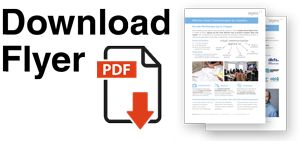How to Create an Effective Graphical Abstract • Guide
What is a graphical abstract?
A graphical abstract (also called ‘visual TOC’ or ‘TOC figure’ or ‘visual abstract’) is a figure that succinctly visually conveys what your research is about. They have been a part of scientific publications for decades in some research fields (e.g. chemistry) but have only recently penetrated other research fields. As there is not a lot of literature on graphical abstracts, I’ll share some of my findings from analyzing thousands of graphical abstracts from different journals.
Graphical abstracts can be split into two categories:
- complex: these are images that aim to comprehensively (yet not in too many details) communicate the essence of your research. They could be about what you’ve done or discovered and are presenting in a scientific paper, or what you aim to research in a grant proposal. What is important is that they are aimed at the right audience and that they simply and clearly present your message. They will usually appear on the 1st page of your manuscript or grant proposal, but you could also use them as a part of your conference poster. You can imagine, that someone will spend at most 30 seconds looking at your complex graphical abstract before they move on to actually read your paper. In a grant proposal, this kind of graphical abstract will quickly tell the evaluator what you aim to achieve, so that the evaluator can then dive into the proposal and find how you aim to achieve it.
- simple: these graphical abstracts will appear together with the title of your manuscript in a table of contents (TOC) of the journal where it is published. You can imagine this image to be viewed very fast while someone (a scientist – your audience) is browsing through the titles of papers published in that journal. The aim of the simple graphical abstract is to draw attention and to ‘hook’ the scientist so they click on your manuscript and also read the abstract. Therefore, in many cases, it is an overkill to present your findings comprehensively in this kind of graphical abstract. It is better to use it as the ‘hook’ as the audience will only spend up to 5 seconds on it.
With this in mind, let’s see how you can achieve the desired effect!
What makes a graphical abstract effective?
A graphical abstract is a figure that clearly and succinctly conveys the main message of your research (paper). The goal of a graphical abstract is that together with the title of the paper, the reader will be drawn to read the whole paper and will easily decide whether the content is interesting. In case you are new to graphical abstracts, I suggest you start by reading what’s a graphical abstract.
What you want to achieve with a graphical abstract is that the reader will quickly and effortlessly understand what your research is about. The important word here is effortlessly, implying that the reader will not have to struggle and think about what exactly you are trying to present. Have in mind, that your research is already pretty complex. You shouldn’t make it even more difficult to understand with a complicated graphical abstract.
The graphical abstract should in a way be self explanatory. The reader should quickly understand it and be able to decide whether to read your paper or not. If you achieve this, your graphical abstract is successful and effective.
The process for creating a graphical abstract
When preparing graphical abstracts at Seyens (our own or for our clients), we usually follow this creative process. It consists of three steps: (1) concept, (2) sketch, and (3) design & refine. The first two steps are done on paper, and we only move to graphic design software for the third step.

1. Concept = content + audience + goal
Concept is the first step of our process. You’ve done your research and have some results and messages to communicate. To meaningfully communicate (and the graphical abstract is a form of communication), you should first consider the three important elements:
- content,
- audience, and
- goal.
Content is your research summarized in a research paper. It is the source from which you will need to define your audience and goal.
Audience is to be defined next. The reason is that different audiences require different approaches in order to get them to the desired goals. When you write a journal paper, you should think about who would be most interested in reading it. Who is the audience that would most benefit from what you have to say? There are a lot of research fields that are somewhat interdisciplinary. For example. When your research results target a specific chemical compound, your most common audience could be analytical chemists. However, maybe there is a value for audiences from medicine, biochemistry, or pharmacy? One of the easiest ways to choose the audience is together with the journal where the paper is being published.
Selecting a goal is (in most cases) defined by the content and audience. In scientific publications, the goal is usually to explain a structure, process, method etc. To highlight and amplify the main message of your paper. Try to limit the message you want to communicate with the graphical abstract in less than 50 words.
The difference between the paper’s abstract and the message for the graphical abstract is that the graphical abstract should only focus on one aspect of the your paper and not try to summarize it whole. Your research paper might have motivations and implications, and it has some research results and methods and so on. In a graphical abstract, you should only focus on one of these, the most important, and ignore the others.

2. Sketch = visually sketch the message on paper
First select the necessary visual elements (a cell, protein, chemical compound, animal …) and the textual elements that will accompany them. If a concept can be presented visually, that is better than described in words. For the text, try including some verbs as they best describe what is going on in the figure. As the space in the graphical abstract is very limited, keep the number of elements to the minimum and simplify the message to bare essentials.
When you are organizing the elements of the sketch, consider that they have to be arranged in some sort of an order. As most of the journal papers are in English language (which is read left-to-right, it is preferred that the message of the figure also follows the ‘western’ principles: organized from left-right, or from top-down.
Another aspect you should consider is to avoid having too many visual elements scattered around the sketch. All elements should be somehow connected to each other, sorted into groups that have something in common. Avoid using boxes around elements that fit together, just put them close together.

3. Design & refine = simplify by removing or grouping
When moving from drawn sketch on paper into your graphic design software, first read the Guide for authors for the journal where you are submitting your paper. The guide will give you information about the font type and size, line-widths, colors, and the dimension of the graphical abstract. It will also mention whether you are to provide it as a PDF, TIFF, or PNG file format.
Use the information from the guide to set-up your graphic design software. Make the dimension of the ‘art-board’ in the exact size the journal requires it. This will allow you to match all element and font sizes with the required from the beginning. Now draw all the visual elements you have on your sketch. You can make your work easier by adding content from repositories which contain free science art figures. Several can be found just by searching on Google or the following sites:
- https://smart.servier.com/ (medical & life science images)
- https://freerangestock.com/category/69/illustrations/page1.html (illustrations)
- https://www.flaticon.com/ (icons)
The last step of the process is to refine what you’ve drawn. To put it bluntly, this means to remove all necessary elements that don’t add to your message. Remember: if a visual element doesn’t add to the message, it detracts from it. Consider it as noise that has to be removed. This is valid for unnecessary elements and for color as well. Make sure that the message is presented unambiguously and is easy to understand.
[social_warfare]

Jernej Zupanc (PhD in Computer Science, 2011) is the founder of Seyens Education Institute. He is an evaluator of H2020 project proposals and a published photographer.



Add comment or question?